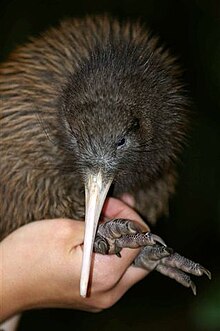
Back Faŭno de Nov-Zelando Esperanto Fána na Nua-Shéalainne Irish החי בניו זילנד HE Fauna Novog Zelanda Croatian Fauna della Nuova Zelanda Italian Фауна на Нов Зеланд Macedonian Animals of New Zealand SIMPLE Фауна Новог Зеланда Serbian Hệ động vật New Zealand Vietnamese

The animals of New Zealand, part of its biota, have an unusual history because, before the arrival of humans, less than 900 years ago, the country was mostly free of mammals, except those that could swim there (seals, sea lions, and, off-shore, whales and dolphins) or fly there (bats). However, as recently as the Miocene, it was home to the terrestrial Saint Bathans mammal, implying that mammals had been present since the island had broken away from other landmasses. The absence of mammals meant that all of the ecological niches occupied by mammals elsewhere were occupied instead by either insects or birds, leading to an unusually large number of flightless birds, including the kiwi, the weka, the moa (now extinct), the takahē, and the kākāpō.


Because of the lack of predators, even bats spend most of their time on the ground. There are also about 60 species of lizard (30 each of gecko and skink), four species of frog (all rare and endangered), and the tuatara (reptiles resembling lizards but with a distinct lineage).
Some butterflies of New Zealand are endemic, while many species have been introduced and some species of butterflies periodically migrate to New Zealand. The Australian painted lady has been known to migrate from Australia to New Zealand in times of strong migration in Australia.[1]
- ^ Dingle, Hugh; Zalucki, Myron P.; Rochester, Wayne A. (1999). "Season-specific directional movement in migratory Australian Butterflies". Australian Journal of Entomology. 38 (4): 323–329. doi:10.1046/j.1440-6055.1999.00117.x.
© MMXXIII Rich X Search. We shall prevail. All rights reserved. Rich X Search